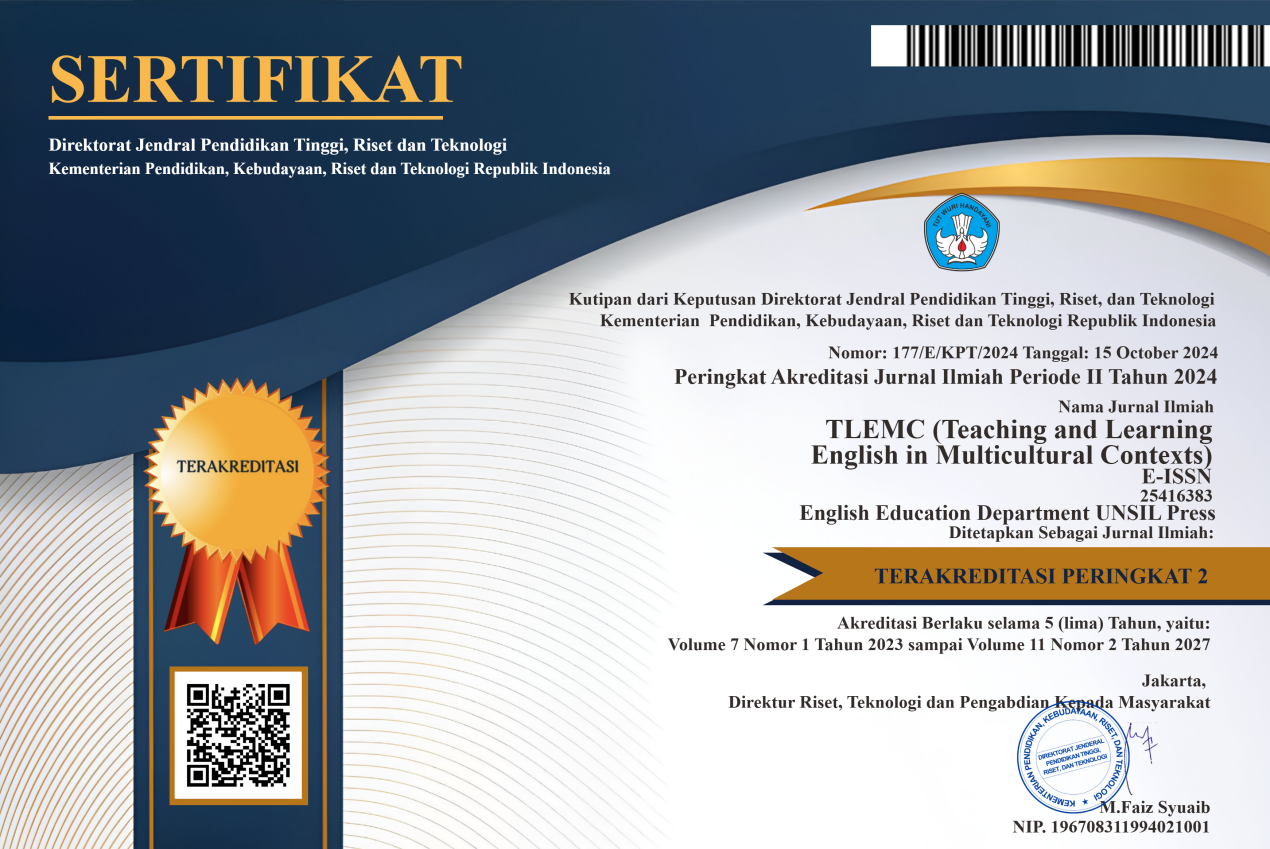What's Up in Whatsapp Classroom: Exploring Students’ Perception in Learning Speaking Through Whatsapp during Covid-19 Pandemic
Abstract
The present study attempted to find out students’ perception and challenges in learning speaking through WhatsApp which was designed with quantitative-descriptive approach in the form of online survey study. The survey was distributed to 51 EFL students at State Islamic University of Mataram. The students’ responses were coded and displayed descriptively into two main themes: students’ perception and students’ challenges. It was found that most of the students, 33 students or 64.7%, perceived WhatsApp as an effective learning platform because it could improve their speaking skill due to its usefulness and ease of use. However, there were 10 students or 19.6% of the students who claimed that WhatsApp was not an effective tool because it was not equipped with more practical features. The students also found it difficult to understand teachers’ explanation through WhatsApp. Another perception is neutral because the students believed that WhatsApp had both advantages and drawbacks. There were 8 students or 15.7% of them perceiving this. Even though the majority of the students showed positive attitude toward WhatsApp-based learning, they agreed to say that they experienced technical, practical and mental challenges during the learning. These challenges need to be anticipated by the teachers and students toward an effective online learning through WhatsApp.Â
Keywords : WhatsApp classroom, technical problems, practical problems, mental problems
Full Text:
PDFReferences
Agung, A. S. S. N., Surtikanti, M. W., & Quinones, C. A. (2020). Students’ Perception of Online Learning during COVID-19 Pandemic: A Case Study on the English Students of STKIP Pamane Talino | Soshum: Jurnal Sosial dan Humaniora. Journal of Social Sciences and Humanities, 10(2). Retrieved from http://ojs.pnb.ac.id/index.php/SOSHUM/article/view/1316
Ali, J. K. M., & Ali Bin-Hady, W. R. (2019). A Study of EFL Students’ Attitudes, Motivation and Anxiety towards WhatsApp as a Language Learning Tool (SSRN Scholarly Paper No. ID 3431782). Rochester, NY: Social Science Research Network. https://doi.org/10.2139/ssrn.3431782
Annamalai, N. (2018). How Do We Know What Is Happening in WhatsApp: A Case Study Investigating Pre-Service Teachers’ Online Activity. Malaysian Journal of Learning and Instruction, 15(2), 207–225.
Bensalem, E. (2018). The Impact of Whatsapp on EFL Students’ Vocabulary Learning. Arab World English Journal (AWEJ), 9(1), 1–38. https://doi.org/10.2139/ssrn.3150707
Brown, H.D. (2000). Principles of Language Learning and Teaching. New York: Longman
Cansoy, R. (2017). Teachers’ Professional Development: The Case of WhatsApp. Journal of Education and Learning, 6(4), p285. https://doi.org/10.5539/jel.v6n4p285
Çetinkaya, L., & Sütçü, S. S. (2018). The effects of Facebook and WhatsApp on success in English vocabulary instruction. Journal of Computer Assisted Learning, 34(5), 504–514. https://doi.org/10.1111/jcal.12255
Chinnery, G. M. (2006). Going to the MALL: Mobile Assisted Language Learning. Language Learning & Technology, 10(1), 9–16.
Davis, F. D., Bagozzi, R. P., & Warshaw, P. R. (1985). A Technology Acceptance Model for Empirically Testing New End-User Information Systems. Retrieved July 31, 2021, from ResearchGate website: https://www.researchgate.net/publication/35465050_A_Technology_Acceptance_Model_for_Empirically_Testing_New_End-User_Information_Systems
GarcÃa-Gómez, A. (2020). Learning through WhatsApp: Students’ beliefs, L2 pragmatic development and interpersonal relationships. Computer Assisted Language Learning, 0(0), 1–19. https://doi.org/10.1080/09588221.2020.1799822
Gasaymeh, A.-M. M. (2017). University Students’ use of Whatsapp and their Perceptions Regarding its Possible Integration into their Education. 11.
Ghee, T. T., Terng, H. F., & Chui, H. C. (2019). Students’ Perception of WhatsApp as an Effective Medium for Enhancing Listening Skill in Foreign Language Learning. Pertanika, 27(2), 833–845.
Hamad, M. M. (2017). Using WhatsApp to Enhance Students’ Learning of English Language “Experience to Share.†Higher Education Studies, 7(4), 74. https://doi.org/10.5539/hes.v7n4p74
Han, T., & Keskin, F. (2016). Uso de la Aplicación Móvil (WhatsApp) para Reducir la Ansiedad al Hablar en Inglés como Lengua Extranjera. GIST – Education and Learning Research Journal, (12), 29–50. https://doi.org/10.26817/16925777.243
Harandi, S. R. (2015). Effects of e-learning on Students’ Motivation. Procedia - Social and Behavioral Sciences, 181, 423–430. https://doi.org/10.1016/j.sbspro.2015.04.905
Harmer, J. (2007). How to Teach English. England: Pearson Education.
Kukulska-Hulme, A., & Shield, L. (2008). An overview of mobile assisted language learning: From content delivery to supported collaboration and interaction. ReCALL, 20(3), 271–289. https://doi.org/10.1017/S0958344008000335
Mbukusa, N. R. (2018). Perceptions of students’ on the Use of WhatsApp in Teaching Methods of English as Second Language at the University of Namibia. Journal of Curriculum and Teaching, 7(2), 112. https://doi.org/10.5430/jct.v7n2p112
Mistar, I. B., & Embi, M. A. (2016). Students’ Perception on the Use of WhatsApp as a Learning Tool in ESL Classroom. Journal of Education and Social Sciences, 4, 9.
Nurazizah, H., Friatin, L. Y., & Sugiarto, B. R. (2019). Whatsapp Voice Note in Speaking Class. Journal of English Education and Teaching, 3(3), 343–360. https://doi.org/10.33369/jeet.3.3.343-360
Plana, M. G.-C., Gimeno, A., Appel, C., Hopkins, J., Gibert-Escofet, M. I., & Figueras, I. (2013, July 10). Improving learners’ reading skills through instant short messages: A sample study using WhatsApp. 4th Worldâ€CALL Conference, Glasgow, 10–13 July 2013.
Popovici, A., & Mironov, C. (2015). Students’ Perception on Using eLearning Technologies. Procedia - Social and Behavioral Sciences, 180, 1514–1519. https://doi.org/10.1016/j.sbspro.2015.02.300
Rafizah, D., Jalil, J. A., & Gunawan, M. N. F. (2015). Community College Students’ Perception Towards Digital Learning In Malaysia. Procedia - Social and Behavioral Sciences, 195, 1798–1802. https://doi.org/10.1016/j.sbspro.2015.06.389
Sa’aleek, A. O. A. (2014). A Review of Emerging Technologies: Mobile Assisted Language Learning (MALL). Asian Journal of Education and E-Learning, 02(06), 469–475.
Susanti, A., & Tarmuji, A. (2016, October). Techniques of Optimizing Whatsapp as an Instructional Tool for Teaching EFL Writing in Indonesian Senior High Schools [Artikel Dosen]. Retrieved May 30, 2020, from International Journal on Studies in English Language and Literature (IJSELL) website: https://www.arcjournals.org/index
Urien, B., Erro-Garcés, A., & Osca, A. (2019). WhatsApp usefulness as a communication tool in an educational context. Education and Information Technologies, 24(4), 2585–2602. https://doi.org/10.1007/s10639-019-09876-5
Venkatesh, V., Morris, M. G., Davis, G. B., & Davis, F. D. (2003). User Acceptance of Information Technology: Toward a Unified View. MIS Quarterly, 27(3), 425–478. https://doi.org/10.2307/30036540
Vygotsky, L. S. (1978). Mind in society: The Development of Higher Psychological Processes. Cambridge MA: Havard University Press.
Warman, L. A. D. (2018). Students’ Perception of Using Whatsapp in Blended Learning on Reading. J-SHMIC : Journal of English for Academic, 5(2), 27–38. https://doi.org/10.25299/jshmic.2018.vol5(2).1848
DOI: https://doi.org/10.37058/tlemc.v5i0.3581
Refbacks
- There are currently no refbacks.
INDEXED BY:
This work is licensed under a Creative Commons Attribution-NonCommercial-ShareAlike 4.0 International License.
![]()
TLEMC (Teaching and Learning English in Multicultural Contexts)
Program Studi Pendidikan Bahasa Inggris
Fakultas Keguruan dan Ilmu Pendidikan
Universitas Siliwangi
Jl. Siliwangi No. 24 Kota Tasikmalaya - 46115
email: tlemc@unsil.ac.id





